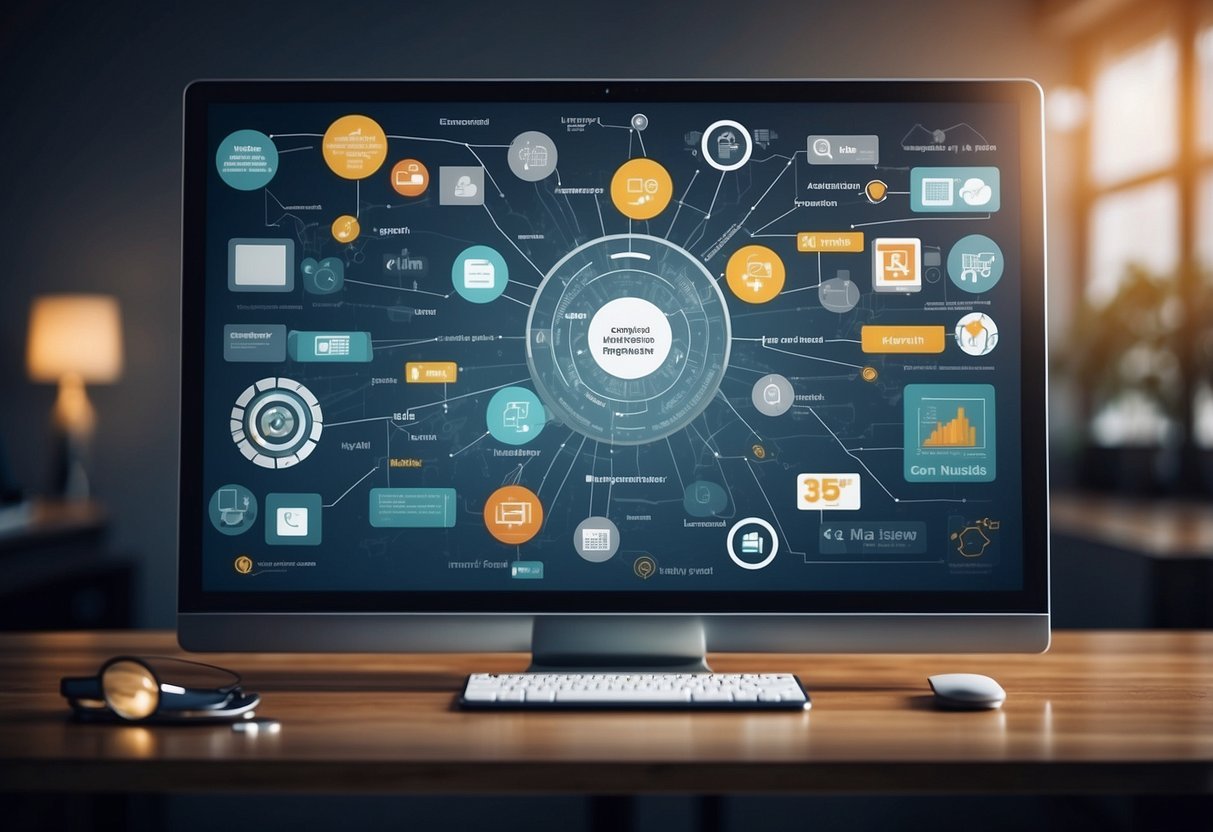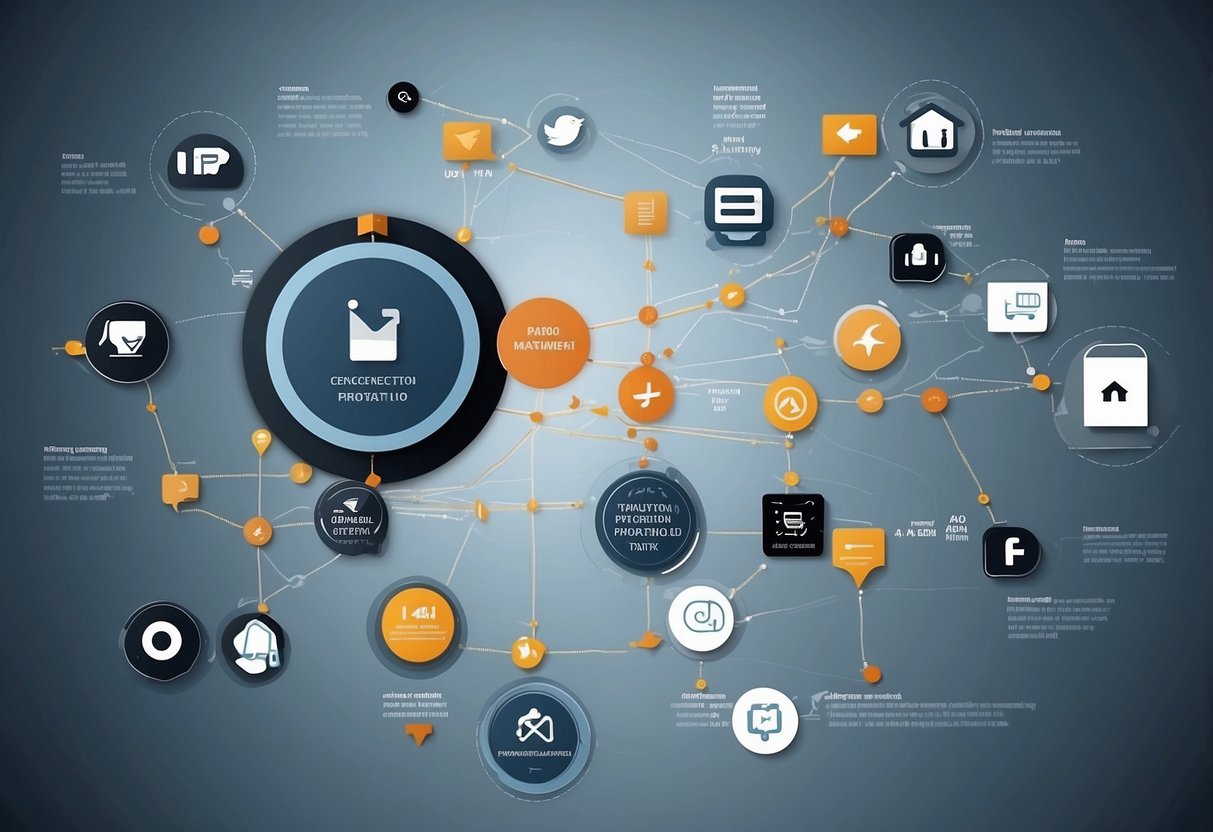Exploring ecommerce marketing automation could be the key that unlocks new potentials for your online business.
By automating repetitive marketing tasks, you can not only save time, but also enhance your customer experience through targeted personalization.
Imagine sending personalized emails or recommendations to your customers without lifting a finger. Marketing automation makes this possible.

Are you tired of juggling too many marketing tasks?
With the right tools, you can automate your workflow and focus on strategies that matter.
It’s about creating a seamless journey for your customers, from their first visit to their final purchase.
Marketing automation lets you engage with your audience at the right time with the right message, boosting both conversion rates and customer satisfaction.
You’ll find that by implementing advanced automation features, you can also analyze and optimize your efforts more effectively.
Automation platforms come equipped with analytics tools that provide invaluable insights, allowing you to tweak your strategy for even better results.
Ready to transform the way you manage your ecommerce business?
Key Takeaways
- Ecommerce marketing automation enhances customer engagement.
- Automated tools personalize and improve customer journeys.
- Analytics in automation helps optimize marketing strategies.
Understanding Ecommerce Marketing Automation
Ecommerce marketing automation is all about leveraging technology to streamline marketing tasks and provide personalized experiences for customers.
Two crucial aspects include defining what marketing automation is in the context of ecommerce and understanding the role of AI and IT in this process.
Defining Marketing Automation in Ecommerce
Marketing automation is the use of software and platforms to automate repetitive marketing tasks.
In ecommerce, this means creating personalized email campaigns, managing customer data, and generating insights from user behavior.
These tools allow you to efficiently handle promotions, sales campaigns, and customer follow-ups without manual intervention.
Imagine having a system that sends out personalized birthday discounts or recommends products based on previous purchases!
These capabilities help in enhancing customer engagement and driving sales.
The Role of AI and IT in Automation
AI and IT play significant roles in marketing automation by making processes smarter and more efficient.
Ever wondered how Amazon knows what products to recommend?
AI analyzes huge amounts of data to predict customer behaviors and preferences.
IT, on the other hand, ensures the seamless integration and performance of these automation tools.
AI-driven insights can help you create more effective marketing strategies, directly impacting your bottom line.
Artificial intelligence and IT support are essential to extracting maximum value from your marketing automation efforts.
So next time you see a well-targeted ad, you know it’s not just luck—it’s smart technology at work!
Setting Up Marketing Automation Tools

Setting up marketing automation tools involves selecting appropriate software and ensuring seamless integration with your existing technology.
Choosing the Right Marketing Automation Software
Choosing the right marketing automation software can be daunting with many options available.
Key aspects to consider include features, ease of use, and integration capabilities.
Marketing automation tools should have robust CRM and analytics features to track customer interactions and measure campaign success.
Common tools like HubSpot, Marketo, and Mailchimp offer various functionalities.
Test each software’s interface before committing. Ensure it’s user-friendly and aligns with your team’s expertise.
Comparing trial versions of different tools can help identify the best match.
Look for automation software that supports future scale and growth to avoid the hassle of switching tools later.
Integrating Automation Tools with Your Tech Stack
Integrating automation tools with your tech stack is crucial.
Ensure compatibility with existing platforms like your CRM, e-commerce platform, and analytics tools.
Seamless integration helps maintain data consistency and streamlines workflows.
Most leading automation tools offer API integration to connect with other software.
Check the documentation for details on compatible tools.
Additionally, consider using middleware solutions like Zapier if direct integration isn’t available.
Ensuring smooth integration will save time and improve efficiency in the long run.
Make a list of all the tools you’re currently using and verify their compatibility with your chosen marketing automation software.
Automating the Ecommerce Workflow

Automating your ecommerce workflow can significantly boost efficiency, customer retention, and conversions.
Streamlined processes and well-crafted email marketing strategies ensure seamless omnichannel automation.
Designing Effective Automated Workflows
Creating efficient workflows requires careful planning.
Start by identifying repetitive tasks, such as order processing or inventory updates. Tools like Zapier, Shopify Flow, or Trello can automate these tasks seamlessly.
Incorporate trigger-based actions. For instance, automatically send an email when an order is received.
Don’t forget to integrate customer relationship management (CRM) for better tracking and personalized interactions.
Testing and adjusting your workflows based on real-time data is crucial. Regularly review performance metrics to ensure everything runs smoothly.
Email Marketing Automation Strategies
Email marketing automation involves sending the right message at the right time.
Use triggered emails based on customer behavior, such as abandoned cart reminders or post-purchase follow-ups.
Segment your email list to tailor content more effectively.
For instance, newsletters for regular updates, or special offers for loyal customers. Tools like Mailchimp and Klaviyo can help manage campaigns and analyze their effectiveness.
Personalization is key. Address customers by name, and reference past purchases to enhance engagement.
Automated email workflows save time while maintaining a personal touch.
Seamless Omnichannel Automation Efforts
Omnichannel automation involves integrating various marketing channels for a consistent customer experience.
Sync social media automation with email and SMS campaigns for unified marketing efforts.
Use tools like Hootsuite to schedule posts across platforms, ensuring a steady online presence.
Connect your CRM to track interactions across multiple channels.
Prioritize customer convenience. Offer options like chatbots for instant support, and synchronize promotions across all channels.
Data-driven decisions can fine-tune your strategy and enhance customer satisfaction.
Tailoring Customer Journeys with Personalization

Personalization in eCommerce marketing automation involves using data to segment and target customers effectively, creating content and recommendations that matter to individuals. This tailored approach enhances customer engagement and drives conversions.
Leveraging Data for Segmentation and Targeting
Using data for segmentation and targeting helps you connect with your customers more meaningfully.
By analyzing purchase history, browsing behavior, and demographics, you can divide your audience into specific groups.
Benefits:
- Increased Relevance: Content and offers that match their needs.
- Higher Engagement: Customers feel understood and valued.
- Better ROI: More efficient use of marketing resources.
For example, a study by Epsilon found that 80% of consumers are more likely to purchase from a brand that provides personalized experiences.
Creating Personalized Content and Recommendations
Creating personalized content means delivering messages and offers that are specifically tailored to individual preferences.
Recommendations can be based on previous purchases, searches, or even abandoned carts.
Strategies:
- Email Campaigns: Personalized subject lines can increase open rates by 26% (Source: Campaign Monitor).
- Product Recommendations: Amazon attributes 35% of its revenue to its recommendation engine.
Tools & Techniques:
- AI Algorithms: Ensure recommendations are accurate and relevant.
- Dynamic Content: Update in real-time based on user interactions.
Using these strategies makes customers feel unique and valued, leading to increased loyalty and repeat purchases.
Ecommerce Engagement and Retention Techniques

Enhancing ecommerce engagement and retaining customers can be challenging, but utilizing SMS, email automation, push notifications, and social media can significantly improve outcomes.
Enhancing Customer Experience with SMS and Email
SMS and email marketing automation are like the dynamic duo of customer engagement. They work together to keep your brand at the forefront of your customers’ minds.
Use SMS to send timely updates and reminders.
For instance, let’s say there’s a flash sale—text messages are quickly read, with a whopping 98% open rate, ensuring your promotions get noticed.
Email marketing automation can help with retention.
Configure emails to go out automatically on customers’ birthdays or anniversaries. You can also set up a series of onboarding emails to welcome new customers.
Segmentation also plays a major role. Tailor your messages to different groups within your customer base to make your communications more relevant and personal.
Combining SMS and email will allow you to cover bases from quick updates to detailed promotional content, driving both engagement and retention.
Utilizing Push Notifications and Social Media
Push notifications and social media management are crucial tools for maintaining engagement.
Push notifications can keep your customers informed and engaged with your app.
For instance, notify them of abandoned carts, special promotions, or order status updates. Studies show that personalized push notifications can increase engagement by 49%.
In the realm of social media, regular interaction builds a loyal community.
Platforms like Facebook, Instagram, and Twitter allow direct communication with customers.
Social media management tools can help schedule posts, engage in real-time conversations, and monitor feedback, enhancing overall customer support.
Keep your messages short and sweet on social platforms. Light-hearted, engaging content, like memes or polls, can create a buzz and keep customers coming back for more.
Analyzing and Optimizing with Ecommerce Analytics

Utilizing ecommerce analytics, you can monitor key metrics and conduct A/B testing to continuously refine your marketing strategies and enhance conversion rates.
Key Metrics and Tracking for Decision Making
Tracking key metrics like conversion rates, average order value, and customer lifetime value is crucial.
Conversion rates indicate how well your site turns visitors into buyers, helping you pin down valuable touchpoints.
You can use tools like Google Analytics for detailed insight. Create detailed reports focusing on user behavior and acquisition patterns to understand which marketing channels drive the most traffic and sales.
Comparing this tracking data over time helps you recognize trends and make informed decisions.
Establishing dashboards that regularly update these metrics can offer a quick snapshot of your business’s progress.
Monitoring cart abandonment rates reveals where customers drop off, guiding improvements.
These insights ultimately lead to better-targeted campaigns and higher ROI.
A/B Testing and Continuous Improvement
A/B testing provides a method to test different versions of a webpage or element to see which performs better.
Tools like Optimizely or VWO make this testing easier.
For instance, test different headlines, CTAs, or images to discover what resonates most with your audience.
Analyze the results to identify which changes positively impact your conversion rates.
Keep tests straightforward and focused on one variable at a time to maintain clarity in your results.
Continuous improvement through A/B testing is key.
Regularly updating elements based on data tracking and test outcomes ensures your ecommerce site stays optimized for performance.
This iterative process can dramatically enhance user experience and boost your conversion rates.
Boosting Sales with Advanced Automation Features

Advanced automation features can significantly boost your ecommerce sales by maximizing revenue from upsell and cross-sell opportunities, automating customer reviews and feedback loops, and recovering lost sales with abandoned cart emails.
Maximizing Revenue through Upsell and Cross-sell
Upselling and cross-selling are powerful techniques to increase your average order value (AOV).
By recommending related or higher-end products during the checkout process, you can encourage customers to spend more.
Automated systems can analyze purchasing behavior to suggest personalized products.
Imagine a customer buying a smartphone. An automated system could suggest a higher-end model (upsell) or complementary items like a case and screen protector (cross-sell).
Personalized automation makes these recommendations more effective, driving additional revenue without manual effort.
Automating Customer Reviews and Feedback Loops
Customer reviews and feedback are crucial for building trust and improving your products.
Automating the collection of reviews not only saves time but also ensures you capture feedback consistently.
Sending automated emails post-purchase can prompt customers to leave a review, boosting your product credibility.
Timely feedback helps you address issues quickly and improve your offerings.
For example, a prompt asking customers to rate their purchase experience can provide insights into areas needing improvement.
Recovering Lost Sales with Abandoned Cart Emails
Abandoned carts represent lost sales opportunities, but automated emails can help recover them.
When a customer leaves items in their cart without completing the purchase, an automated system can send reminders, often increasing the chances of conversion.
Personalized abandoned cart emails can include special offers or discounts, encouraging customers to complete their purchase.
Sometimes, a simple reminder is all it takes to recover lost sales and boost your overall revenue.
Selecting Ecommerce Automation Platforms and Tools

Finding the right ecommerce automation platform can make a significant difference in the efficiency and effectiveness of your marketing efforts. Here, we’ll explore the top providers and what to look for when choosing the best tool for your needs.
Comparing Top Providers: Klaviyo, HubSpot, and More
Klaviyo: Known for its ease of use and deep integration with ecommerce platforms like Shopify and WooCommerce, Klaviyo offers detailed analytics and advanced segmentation. It’s a favorite for small to mid-sized businesses looking for comprehensive email and SMS marketing solutions.
HubSpot: HubSpot is a powerful platform that offers marketing automation, CRM, and sales tools in one package. It’s an excellent choice for businesses wanting an all-in-one solution.
Though it’s more expensive, the extensive features and scalability can justify the cost, particularly for growing businesses.
Mailchimp: Popular for its user-friendly interface and affordability, Mailchimp is suitable for small businesses. It offers basic automation features but may lack the depth of analytics and customization options found in other tools.
ActiveCampaign: Known for its robust automation capabilities, ActiveCampaign provides advanced customer journey mapping and CRM integration. It’s well-suited for businesses that require highly targeted and personalized campaigns.
Omnisend: Aimed at ecommerce, Omnisend offers advanced segmentation, automation, and omnichannel support, including email, SMS, and more. It’s particularly useful for businesses looking to engage customers on multiple platforms.
Factors to Consider: Pricing, Features, and Scalability
Pricing: When selecting a tool, consider both the upfront and ongoing costs. Platforms like Mailchimp are budget-friendly for small businesses, while options like HubSpot can be more expensive but offer greater value as your business grows.
Features: Key features to look for include automation workflows, segmentation, CRM integration, and analytics.
Ensure the platform you choose can handle your current needs and grow with your business. For instance, ActiveCampaign excels in personalization and customer journey mapping.
Scalability: Think about your future needs. Will the platform support your business as it grows?
Tools like HubSpot offer scalable solutions, while others like Klaviyo are great for starting out but also capable of handling high volumes of data and interactions.
Ease of Use: The user experience matters.
Platforms like Mailchimp and Omnisend are noted for their intuitive interfaces, making it easier to set up and run campaigns without extensive technical knowledge.
Building a Strategic Marketing Automation Plan

Creating an effective marketing automation plan for ecommerce companies involves defining clear goals and meticulously mapping out the automation workflows. It’s essential to measure success through specific KPIs like time to value and other performance metrics.
Defining Goals and Mapping Out Automation Workflows
A solid marketing automation plan starts with setting clear, achievable goals.
Think about what you want to achieve: Is it increasing customer retention, boosting sales, or enhancing customer engagement?
Your goals should be SMART: Specific, Measurable, Achievable, Relevant, and Time-bound.
Once you’ve got your goals in place, it’s time to map out your workflows.
Picture this: A new customer signs up for your newsletter. What happens next?
Perhaps they receive a welcome email, followed by a series of emails offering them valuable information or exclusive discounts.
Using tools like customer relationship management (CRM) software can be a game-changer.
Many ecommerce marketers deploy systems like HubSpot or Salesforce to design and manage their campaigns.
Create detailed flowcharts that visualize each step of the customer journey. This helps identify gaps and ensures a seamless experience.
Measuring Success: Time to Value and Other KPIs
Measuring the success of your marketing automation is crucial. How do you know if your efforts are paying off?
Start by looking at the time to value (TTV). This measures how quickly your customers realize the value of your product or service after they engage with your automation workflows.
Other important performance metrics include click-through rates (CTR), conversion rates, and customer lifetime value (CLV). For instance, if your workflows are designed to upsell products, you should see an increase in average order value over time.
Companies often use dashboards and analytic tools to track these metrics in real-time. Regularly review these reports to tweak and optimize your strategies.
You might find that a particular email sequence is underperforming. This indicates a need for A/B testing or content revision.
Strategically focusing on these KPIs not only helps in assessing your current strategies but also guides future marketing initiatives. This ensures continuous improvement and success.




